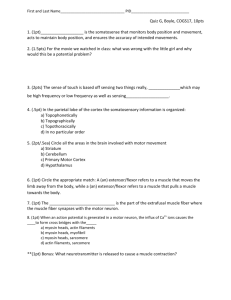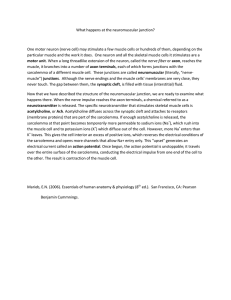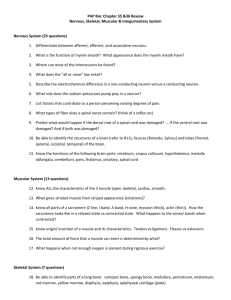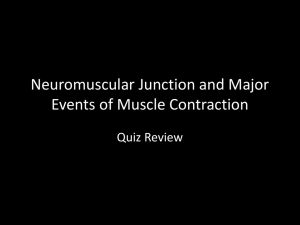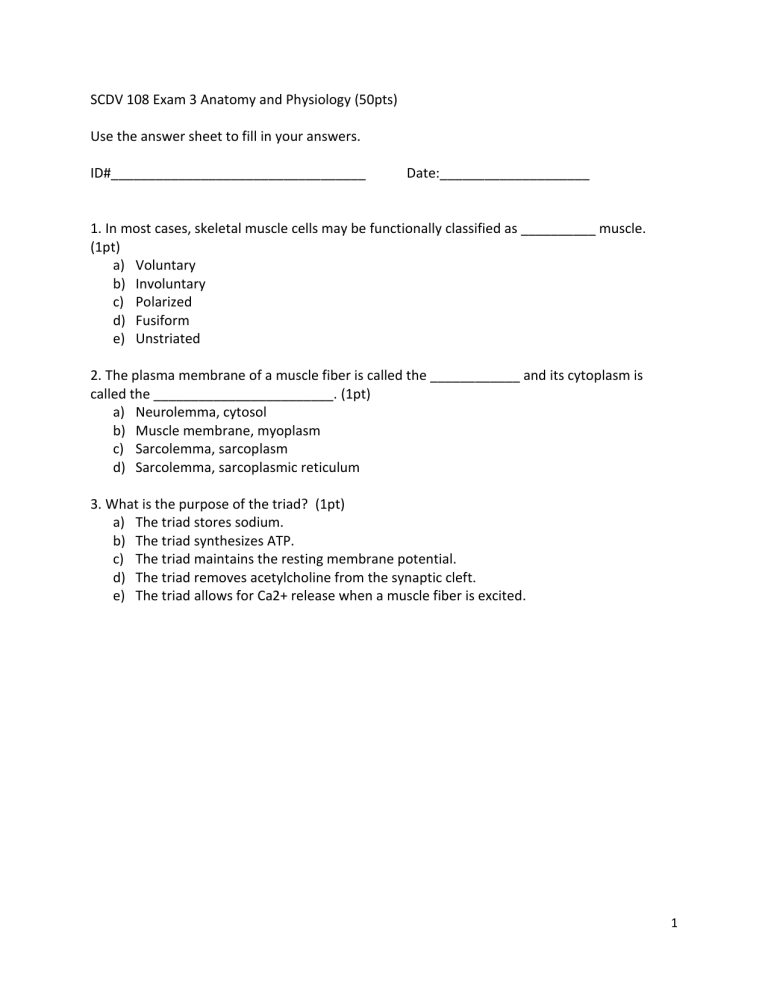
SCDV 108 Exam 3 Anatomy and Physiology (50pts) Use the answer sheet to fill in your answers. ID#__________________________________ Date:____________________ 1. In most cases, skeletal muscle cells may be functionally classified as __________ muscle. (1pt) a) Voluntary b) Involuntary c) Polarized d) Fusiform e) Unstriated 2. The plasma membrane of a muscle fiber is called the ____________ and its cytoplasm is called the ________________________. (1pt) a) Neurolemma, cytosol b) Muscle membrane, myoplasm c) Sarcolemma, sarcoplasm d) Sarcolemma, sarcoplasmic reticulum 3. What is the purpose of the triad? (1pt) a) The triad stores sodium. b) The triad synthesizes ATP. c) The triad maintains the resting membrane potential. d) The triad removes acetylcholine from the synaptic cleft. e) The triad allows for Ca2+ release when a muscle fiber is excited. 1 4. The process of muscle contraction and relaxation has four major phases. These phases are 1) excitation, 2) excitation-contraction coupling, 3) contraction, and 4) relaxation. The following questions relate to these major phases. Excitation-contraction coupling refers to events that link action potentials on the sarcolemma to activation of the myofilaments preparing them to contract. Action potentials spread from the motor end plate in all directions. When the excitation reaches _________, it propagates down them into the cell interior. Action potentials open voltage-gated ion channels in ___________ that ultimately open channels that release _____________from sarcoplasmic reticulum. (1pt) a) Actin, Tropomyosin, sodium b) Troponin, Troponin, calcium c) the T tubules, the T tubules, calcium d) Mitochondria, A-Band, calcium 5. In the diagram above, which of the following structure carries and facilitates action potentials that cause ion channels to open in muscle cell organelles? This eventually leads to muscle contraction. It is part of the “triad”. (1pt) a) 1 b) 2 c) 3 d) 4 e) 5 2 6. In the diagram above, which of the following structures designates the “I” or isotropic band? (1pt) a) 1 b) 2 c) 3 d) 4 e) 5 7. Fill in the correct answer: Arrival of an action potential at the axon terminal of a motor neuron causes the fusion of acetylcholine-containing synaptic vesicles with the pre-synaptic plasma membrane of the axon terminal. Acetylcholine then diffuses across the synaptic cleft to bind to and activate acetylcholine receptors. Activation of the acetylcholine receptors leads to an initial depolarization BEFORE a skeletal muscle action potential is initiated. The initial depolarization of the skeletal muscle plasma membrane at the neuromuscular junction is referred to as a __________________________.(1pt) 8. Which of the following is (are) true about the H zone in a striated muscle sarcomere unit? a) This zone is the distance between the ends of the thin filaments that extend from opposite ends (Z disks) of the same sarcomere unit. (1pt) b) Its length is constant c) Its length is variable d) A and B only e) A and C only 9. The thin filaments of muscle fibers are made of the following protein: (1pt) a) Actin b) Myosin c) Tubulin d) Albumin e) Tropomyosin 10. Which of the following is (are) true about the H band or zone in a striated muscle sarcomere unit? (1pt) a) This zone is the distance between the ends of the thin filaments that extend from opposite ends (Z disks) of the same sarcomere unit b) Its length is constant regardless of relaxation or contraction of the sarcomere c) Its length varies based on the contraction or relaxation of the sarcomere d) A and B only e) A and C only 3 11. What happens when acetylcholine stimulates its receptors in the neuromuscular junction? a) The release of Ca2+ from the sarcoplasmic reticulum decreases. (1pt) b) The permeability of the sarcolemma to Na+ increases. c) The positive charge on the sarcolemma decreases. d) The threshold of the muscle fiber lowers. 12. The image above shows part of the sliding filament theory of muscle contraction where the muscle is being prepared to contract. Label the four components that you see in the diagram. (4pts) 1. _________________(don’t forget to name the cation too) 2. __________________ 3. ________________(two yellow ovals) 4. __________________ 13. Based on the image above, what is happening to the globular head of myosin? (1pt) a) Cocking and activation b) Performing the power stroke c) Cross-bridging d) Binding calcium 4 14. The process of muscle contraction and relaxation has four major phases. These phases are 1) excitation, 2) excitation-contraction coupling, 3) contraction, and 4) relaxation. The following questions relate to these major phases. During excitation, an action potential arrives at the axon terminal of a neuron at the neuromuscular junction and opens voltage-gated calcium channels that (1 pt) a) stimulate synaptic vesicles to release a neurotransmitter b) inhibit postsynaptic potentials c) flood the neuron with inhibitory charges d) block acetylcholine receptors 15. A volleyball player depends on the gastrocnemius muscles for plantarflexion, whereas a marathon runner depends more on the soleus muscles for the same action. What characteristic of the soleus muscles makes this so? (1 pt) a) They have smaller mitochondria. b) They have more glycogen in them. c) They don't have as many blood capillaries per gram of tissue. d) They make more use of aerobic respiration. e) They break ATP down to ADP and Pi faster. 16. Fill in the correct answer: A motor neuron and all of the skeletal muscle fibers it controls are collectively referred to as a _________________________. (1 pt) 17. Sort each movement by the type of motor unit used to achieve the movement. (3pts) a) Typing text message b) Climbing a rope at the CrossFit gym c) Lifting a 25lb dumbbell over your head d) Playing the flute e) Reading your textbook f) Standing on the deck of a moving boat Small motor units 1._______________ 2.______________ 3.______________ Large motor units 4. _______________ 5. _______________ 6. _______________ 5 18. A skeletal muscle generates the greatest tension when it is __________. (1 pt) a) greatly stretched before being stimulated b) partially stretched before being stimulated c) fully relaxed before being stimulated d) well-rested and low in creatine phosphate e) high in lactate concentration 19. The somatic sensory division of the peripheral nervous system carries signals (1 pt) a) From receptors in the skin, muscles, bones, and joints b) To skeletal muscles c) From viscera of the thoracic cavities mainly d) To glands, cardiac muscle, and smooth muscle e) From the spinal cord to muscles 20. Fill in the blank: Myelinated axons allow the action potential to "jump" from node to node. This type of action potential propagation is known as __________ conduction. (1 pt) 21. Label the components in the image above using some (not all) of the terms listed: Node of Ranvier, Soma, Myelin, Axon, Axon hillock, Dendrite, Oligodendrocyte, Astrocyte, Axon collateral, Synaptic terminal, Neurofibril (6pts) 1.______________ 2.______________ 3.______________ 4.______________ 5.______________ 6.______________ 6 22. These glial cells are responsible for the secretion of the cerebrospinal fluid (CSF). (1 pt) a. Astrocytes b. Oligodendrocytes c. Schwann cells d. All ependymal cells lining the brain ventricles e. Ependymal cells of the choroid plexuses 23. The most abundant glial cells of the nervous system are: (1 pt) a. Astrocytes b. Oligodendrocytes c. Schwann cells d. Ependymal cells e. Microglia 24. What is occurring in number 2? (1 pt) a) Action potential from presynaptic neurons are depolarizing the dendrites and soma of the postsynaptic neuron leading to graded stimulation. b) The neuron is hyperpolarized at this stage and is unable to carry an action potential. c) Voltage-gated sodium channels are open along the axon of the postsynaptic neuron d) The neuron is repolarizing and potassium ions are leaking into the intracellular fluid. 25. What is occurring in number 6 above? (1 pt) a) b) c) d) Sodium channels are wide open and sodium is pouring into the intracellular fluid. Potassium channels are wide open and potassium is pouring in to the intracellular fluid Slow potassium channels are fully open and potassium is leaving the cell. The neuron is hyperpolarized at this stage 7 26. A change in the membrane potential from the resting value of −50mV to a new value of −10mV is referred to as: (1 pt) a. Depolarization b. Hyperpolarization c. Repolarization d. resting membrane potential 27. Which of the following is NOT true about the neuronal action potential? (1 pt) a) Action potentials are all-or-nothing b) Action potentials travel along axons in a non-decremental fashion (i.e. does not decrease) c) The spike phase of the action potential is due to the opening of voltage-gated Na+ channels d) Repolarization and hyperpolarization are due to the activity of K+ channels e) All of the above are true about action potentials 28. For every ATP molecule hydrolyzed by the Na+/K+ ATPase (also referred to as the Na+ pump): (1 pt) a) 2 Na+ ions are transported into the cell and 3 K+ ions are transported out of the cell b) 2 Na+ ions are transported out of the cell and 3 K+ ions are transported into the cell c) 3 Na+ ions are transported into the cell and 2 K+ ions are transported out of the cell d) 3 Na+ ions are transported out of the cell and 2 K+ ions are transported into the cell 8 29. In the diagram above, number 1 refers to (1 pt) a) The relative refractory phase of an action potential. If a second stimulus is applied to the neuron (no matter how strong the stimulus), during this phase a second action potential will not be generated. b) The absolute refractory phase of an action potential. If a second stimulus is applied to the neuron (no matter how strong the stimulus), during this phase a second action potential will not be generated. c) The tetanus phase of an action potential. If a second stimulus is applied to the neuron (no matter how strong the stimulus), during this phase a second action potential will not be generated. d) The depolarization phase of an action potential. If a second stimulus is applied to the neuron during this phase, and it is strong, a second action potential will be generated. 9 30. Label the diagram below of a spinal cord in traverse section. (4 pts) 1. ______________________________ 2.______________________________ 3. ______________________________ 4._____________________________ 31. Which of the following fractures would be the least likely to cause a spinal cord injury? (1 pt) A fracture of vertebra C2 A fracture of vertebra C6 A fracture of vertebra T5 A fracture of vertebra T12 A fracture of vertebra L4 32. Reflex arcs that only use two neurons are called ____________ reflex arcs. (1 pt) a) ipsilateral b) contralateral c) polysynaptic d) monosynaptic e) autonomic 10 33. In the patellar tendon reflex arc, the patellar ligament is stretched, which stretches the quadriceps femoris muscle of the thigh. This reflex will cause the quadriceps femoris to __________ and the hamstrings to __________. (1 pt) a) b) c) d) contract; relax contract; contract relax; contract relax; relax 34. You go to the movies after a long day and you begin to nod off as soon as the movie starts. Your head starts to lower a little, but a reflex causes your head to rise. This is called the __________ reflex. (1 pt) a) tendon b) crossed extension c) withdrawal d) stretch (myotatic) e) flexor (withdrawal) 35. A nurse pricks your finger to type your blood. You flinch at the pain, pulling your hand back. This is called the __________ reflex. (1 pt) a) painful b) stretch c) flexor (withdrawal) d) tendon e) crossed extension 36. Tendon organs are __________. (1 pt) a) chemoreceptors b) visceral receptors c) proprioceptors d) pain receptors e) nociceptors 11
